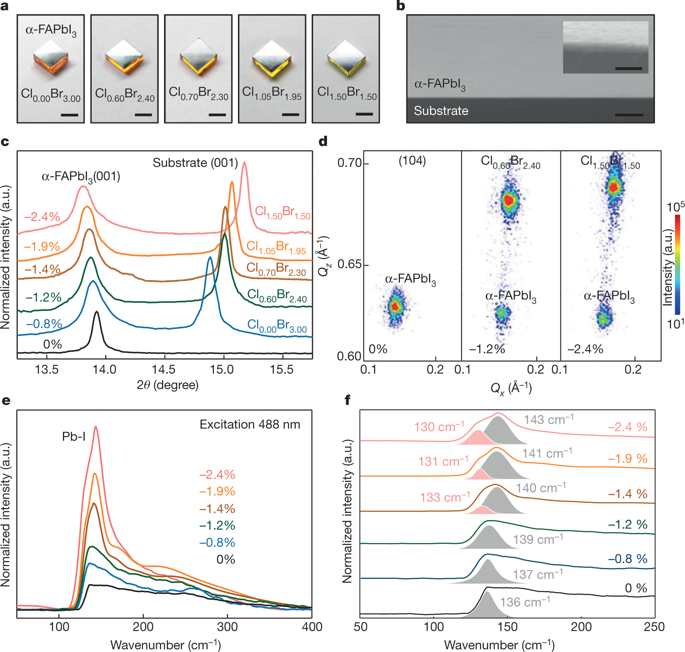Nature ( IF 50.5 ) Pub Date : 2020-01-08 , DOI: 10.1038/s41586-019-1868-x Yimu Chen 1 , Yusheng Lei 1 , Yuheng Li 1 , Yugang Yu 2 , Jinze Cai 2 , Ming-Hui Chiu 3 , Rahul Rao 4 , Yue Gu 2 , Chunfeng Wang 1 , Woojin Choi 5 , Hongjie Hu 2 , Chonghe Wang 1 , Yang Li 1 , Jiawei Song 2 , Jingxin Zhang 2 , Baiyan Qi 2 , Muyang Lin 1 , Zhuorui Zhang 1 , Ahmad E Islam 4 , Benji Maruyama 4 , Shadi Dayeh 1, 2, 5 , Lain-Jong Li 3, 6 , Kesong Yang 1 , Yu-Hwa Lo 2, 5 , Sheng Xu 1, 2, 5, 7

|
Strain engineering is a powerful tool with which to enhance semiconductor device performance1,2. Halide perovskites have shown great promise in device applications owing to their remarkable electronic and optoelectronic properties3,4,5. Although applying strain to halide perovskites has been frequently attempted, including using hydrostatic pressurization6,7,8, electrostriction9, annealing10,11,12, van der Waals force13, thermal expansion mismatch14, and heat-induced substrate phase transition15, the controllable and device-compatible strain engineering of halide perovskites by chemical epitaxy remains a challenge, owing to the absence of suitable lattice-mismatched epitaxial substrates. Here we report the strained epitaxial growth of halide perovskite single-crystal thin films on lattice-mismatched halide perovskite substrates. We investigated strain engineering of α-formamidinium lead iodide (α-FAPbI3) using both experimental techniques and theoretical calculations. By tailoring the substrate composition—and therefore its lattice parameter—a compressive strain as high as 2.4 per cent is applied to the epitaxial α-FAPbI3 thin film. We demonstrate that this strain effectively changes the crystal structure, reduces the bandgap and increases the hole mobility of α-FAPbI3. Strained epitaxy is also shown to have a substantial stabilization effect on the α-FAPbI3 phase owing to the synergistic effects of epitaxial stabilization and strain neutralization. As an example, strain engineering is applied to enhance the performance of an α-FAPbI3-based photodetector.
中文翻译:

卤化物钙钛矿的应变工程和外延稳定化
应变工程是一种强大的工具,可用来提高半导体器件的性能1,2。卤化物钙钛矿由于其卓越的电子和光电特性3,4,5在器件应用中显示出巨大的前景。尽管经常尝试对卤化物钙钛矿施加应变,包括使用静水加压6、7、8、电致伸缩9、退火10、11、12、范德华力13、热膨胀失配14和热诱导基板相变15,由于缺乏合适的晶格不匹配外延衬底,通过化学外延对卤化物钙钛矿进行可控和器件兼容的应变工程仍然是一个挑战。在这里,我们报告了卤化物钙钛矿单晶薄膜在晶格不匹配的卤化物钙钛矿衬底上的应变外延生长。我们使用实验技术和理论计算研究了α-甲脒碘化铅(α-FAPbI 3 )的应变工程。通过调整衬底成分——以及因此其晶格参数——高达 2.4% 的压缩应变被施加到外延 α-FAPbI 3薄膜上。我们证明了这种应变有效地改变了晶体结构,降低了带隙并增加了 α-FAPbI 的空穴迁移率3 . 由于外延稳定和应变中和的协同作用,应变外延也显示出对α-FAPbI 3相具有显着的稳定作用。例如,应用应变工程来提高基于 α-FAPbI 3的光电探测器的性能。









































 京公网安备 11010802027423号
京公网安备 11010802027423号